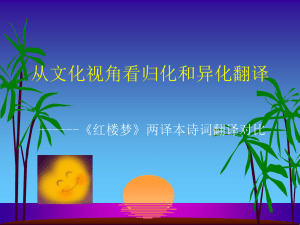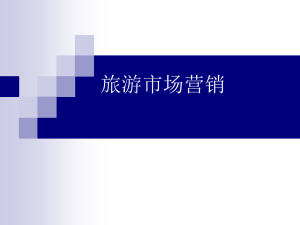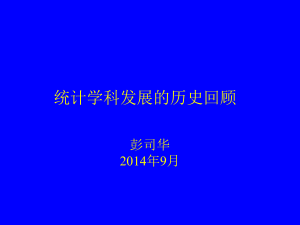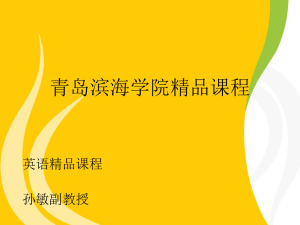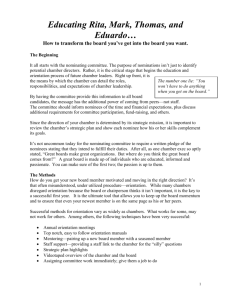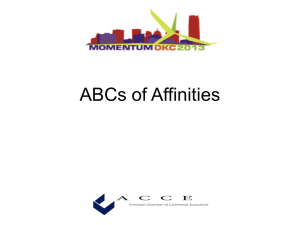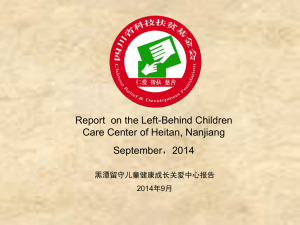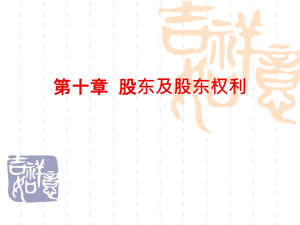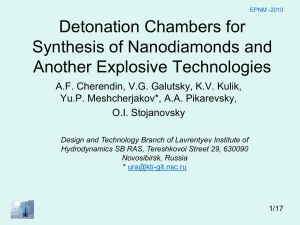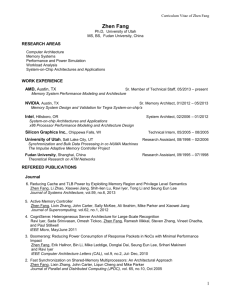第二章汉英文化对比 - 精品课程
advertisement
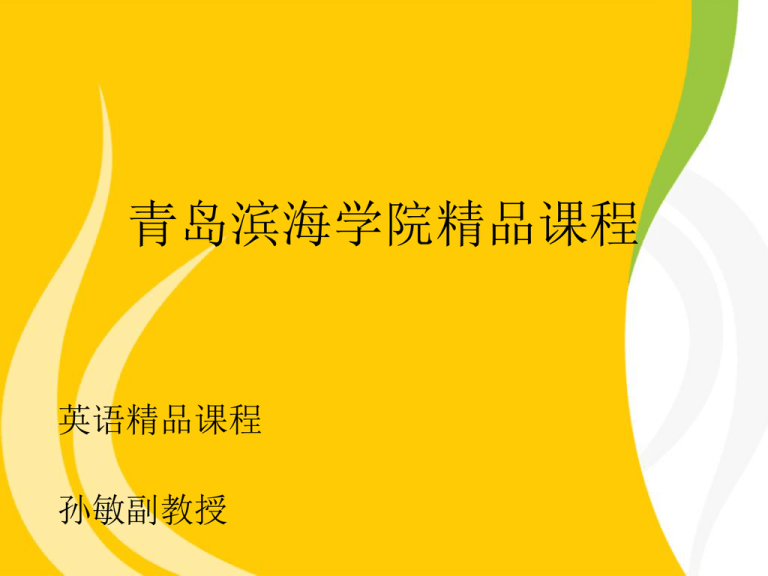
青岛滨海学院精品课程 英语精品课程 孙敏副教授 第二章 汉英文化对比 第一节文化和语言的关系 第二节 语言中的文化因素解析 第三节 文化与翻译 实践一 实践二 课后作业 第一节文化和语言的关系 一、文化 1.广义文化:指人类社会历史实践过程中所创造的物质财富和精神财 富的总和。 2.狭义的文化:指社会意识形态,以及与之相适应的制度和组织机构; 有时也指教育、科学、文学、艺术等方面的精神财富,以便与政治、经 济、军事等方面的知识和设施相区别。 (戚雨村,《语言•文化•对比》) 广义的文化包括三个层面的内容;(1)物质文化,例如建筑物、服饰、 食品、工具等;(2)制度习俗文化,包括制度、法规以及相应的设施 和风俗习惯等等;(3)精神文化,包括价值观念、思维方式、审美趣 味、道德情操、宗教信仰等,也包括哲学、科学、文学艺术方面的成就 和产品。 二、文化中的语言 文化和语言密不可分。语言是文化的一部分,是极其重要的一部分,因 此可以说,文化是语言活动的大环境。文化反映在语言文字中,文化又 村子于使用该语言文字民族的知识结构中。 目录 三、语言中的文化 语言是文化的一部分,但语言同时又是文化的载体,人类的各种文化只 有通过语言才能传播、交流、发展、延续。所以各种文化因素能在语言 中找到根据。语言文字当中,处处都有文化的烙印;语言活动过程中, 时时可觅间文化的踪迹。 目录 第二节 语言中的文化因素解析 一、词汇中的文化 中英两种文字大都具有对应的词语。有些是反映中国文化特有事物和 现象的词语,如“盘古”、“女娲”、“秀才”、“八股文”、“太 极拳”“个体户”等等。从翻译的角度看,这类词虽然在英语里找不 到意义完全对等的词语,却不是语义转换的主要障碍,通过阐释或注 解总有办法把它们的意思解释清楚并传达过去。我们这样说,仅仅是 对这些词语的所指意义而言。所以上述词语只能说属于概念意义的空 缺,而不是文化意义上的空缺。 我们所说的文化意义指词语概念意义之外的、能产生联想的内涵意义。 具有这类双重意义的词语往往构成翻译的主要障碍,因为它们常常兼 指多义,甚至以内涵意义为主。这样的词语,虽然能在英语里找到概 念相同的词语,却可能出现文化含义的不对应或假对应。注意下面意 义相同的词语在文化内涵上的差别: 目录 (1)红(喜庆)—red(暴力) (2)白(丧服)—— white (婚纱) (3)蓝(蓝色)—blue(清高、忧郁、淫秽) (4)黄 (王权,淫秽)—yellow(怯懦) (5)牧童(悠闲) —cowboy(冒险) (6)农民(忠厚老 实)—peasant(心胸狭窄) (7)狗 (鄙视) —dog (同情) (8)龙(高贵)— dragon(凶恶) (9)月亮(团圆)—moon(虚幻) (10)宣传(中性 词)—propaganda(贬义词) 二、成语中的文化 汉语和英语都有大量的成语、言语和比喻手段。它们的 结构。语义和用法在很大程度上受到所处具体文化环境 的制约,因此一般能过比较突出地反映文化和语言的差 异。这类词语在理解上超出了其文字的本意,其交际价 值在于语用意义,具有强烈的文化特征。 目录 下列汉英成语具有相似所概念意义,其语用意义却不同,请试作说明 1.打草惊蛇—to beat about bush (to approach a subject without coming to the point, try to say something indirectly 旁敲侧击) (汉语内涵意义:to alert the enemy by rash or accidental events before carrying out the planned attack) 2.亡羊补牢—to lock the stable door after the horse has been stolen (take precautions when it is too late) (汉语内涵意义:to repair the stable after a sheep is gone, still in time to avoid further losses) 3.骨鲠在喉— to have a bone in one’s throat (to avoid making one’s opinion known) (汉语内涵意义:to have an opinion that one cannot express) 4.同舟共济— to be in the same boat (to be in the same difficult situation or dangers) (汉语内涵意义:to cooperate and help each other in order to ride out a difficulty) 5.怒发冲冠—to make one’s hair stand on end (to fill one with fight or horror) (汉语内涵意义:to bristle with anger, to fly into a rage, to be in violent anger) 6.翻天覆地—to move heaven and earth (to do one’s utmost) (汉语内涵意义:epoch-making, earth-shaking ) 7.蜀犬吠日— to bark at the moon (to make fruitless efforts) (汉语内涵意义:to make a fuss about something that one alone finds strange, un-called for alarm or excitement out of sheer ignorance) 8.洗手不干—to wash one’s hands of (to refuse to take any more responsibility for sb.or sth.) (汉语内涵意义:(of a thief, ect) to stop doing wrong and reform oneself ) 9.食言— to eat one’s words (to take back what one has said) (汉语内涵意义:to go back on one’s word, to break one’s word 10.扯后腿—to pull somebody’s leg (to tell someone something untrue as a joke, try to make somebody believe something that is untrue as a joke) (汉语内涵意义:to hinder, to be a hindrance to sb.) 三、语用方面的文化差异 语言中凡涉及社会应酬与人际关系的词语物不打有独特的民族文化的烙 印。中国人说自己时用谦称,指对方时用敬称。叫对方“老李”表示亲 热,称呼“李老”则表示恭敬。而英美人则怕“老”(old)字,也恨 “老”字。中国人有一大串指代自己或与己有关的谦词,如“寒舍”、 “菲酌”、“敝人”“薄酒”、“在下”、“犬子”、“贱内”、“不 才”、“老朽”、“拙作”、“愚见”等;对对方有一连串敬称,如 “您”、“令尊”,“令堂”、“令爱”、“贵舍”、“贵校”、“高 见”、“高足”、“大作”、“鸿论”等。英美文化中没有这种厚彼薄 己的“自贬”传统,因此在语言上也找不到对应的词语。接受礼品或谢 意时中国人也要自谦一番,说“不敢当”、“受之有愧”、“过奖”之 类的花,西方人则坦率地认可,使用“I’m so glad”, “It’s so lovely”, “Thank you”等语句。 翻译实践 将下列句子译成英文: 1.惭愧(不敢当,哪里)。I’m pleased that you think so. (I’m pleased to hear that. You flatter me. Thank you for your compliment. 2.欢迎,欢迎(幸会;久仰)。 Glad to meet you. (I’m pleased to see you. It’s such a pleasure to see you.) 3.再会(保重;有空来玩儿)。 Good-bye. (Take care. See you. Do come again.) 4.请笑纳(别嫌弃;一点意思)。 I hope you will like it. (Please accept it.) 5.您太客气(让你破费,不好意思)。 It’s so lovely!(Thank you for the gift) 6.多谢(有劳您了;累您了)。 Thanks.(Many many thanks. I’m much obliged) 7.别客气(别见外;没什么)。 Don’t mention it. (It’s a pleasure. Not at all. You’re welcome. Never mind.) 8.劳驾(请问;有劳您……)。 Excuse me…(Could you be so kind as to…Would you please…? May I trouble you…?, Would you mind…? 9.不见不散啊! Please be there on time. (Till then. See you. Be there and be square) 10.恭喜发财! Good luck! 11.一路顺风! Plain sailing! (Have a good journey. May the favorable wind accompany you.) 12.该死! Damn it! 13.没错。 You bet. (No mistake. Certainly) 14.没门儿。 No way. 15.完全同意。 I couldn’t agree more. (How right you are!) Part Three Summary (总结) 汉英语言中的文化差异:主要体现在词汇、成语及语用等方面,构成汉 英不对应。 Part Four Homework 一.翻译下列词语,注意汉英文化形象的不同。 1.铁饭碗 the iron rice-bowl 2.半边天 half the sky 3.暴发户 instant rich 4.纸老虎 paper tiger 5.洗手不干 wash one’s hand out of a thing 6.隐形眼镜 contact lenses 7.易拉罐 pop-top; pull-top 8.红榜 honor roll 9.垄断 monopoly 10.(旅游)旺季/淡季 high season/low season 二.将下列汉语成语译成英语: 1.火上浇油 to pour oil on the flame 2.浑水摸鱼 to fish in troubled water 3.晴天霹雳 like a bolt from the blue 4.昭然若揭 as clear as the sun at noonday 5.弱不禁风 as weak as water 6.呆若木鸡 to be petrified with astonishment 7.暗箭伤人 to hit someone below the belt/stab someone in the back 8.出言不逊 to scold like a fish-wife 9.扬眉吐气 to hold one’s head high 10. 惹是生非 to bring a hornet’s (马蜂)net about one’s ears 第三节 文化与翻译 翻译中,文化因素的处理时十分重要的任务。华夏文化与历史悠久的汉 语言文字有千丝万缕的练习。汉语译成英语时,不但文化的载体改变了, 文化的读者环境也不负存在。这时就会出现两种情形:首先,译入语没 有相应的词语来承载原语中的文化要素,形成词语空缺。其次,译文受 众缺乏理解原文所需要的汉文化背景知识,或者以自己的文化背景去理 解译文,造成误解。翻译时,我们应对原文文字众的文化含义有敏锐的 察觉、准确的把握,对原文蕴涵的文化背景在译文众进行适当的补充, 对在异族文化众容易误解的概念进行必要的澄清,帮助译文读者跨越文 化障碍。 一、概念意义与文化意义完全相同 这类词语属于能够“直译“的词句,原文的概念意义和文化意义、形象 与寓意同时传达到译文当中。例如: 露面— to show one’s face, to show up 丢脸— to lose face, face-losing 老手—an old hand 笑柄—a laughing stock 碰壁— to run one’s head against a wall 好心— kind-hearted 浑水摸鱼— to fish in troubled waters 破涕为笑— to smile through one’s tears 一只耳朵听,一只耳朵冒— to go in at one ear and out at the other 祸不单行— Misfortune never comes singly 趁热打铁— Strike while the iron is hot. (2)姥姥既是这么说,况且当日你也见过这姑太太一次,为什么不你 老人家明天就去一遭,先试试风头儿去?(曹雪芹《红楼梦》) Since this is your idea, mother, and you’ve called on the lady before, why not go there tomorrow and see how the wind blows? (3)三月里刘熏宇君来信,说互生生病了,而且是没有希望的病,医生说 只好等日子了。四月底在《时事新报》上见到立达学校的通告,想不到 这么快互生就殁了!(朱自清《哀互生》) In March I heard from Mr.Liu Xunyu that Hesheng was sick and hopelessly sick at that. The doctor said there was nothing he could do but wait for the day to arrive. Toward the end of April, I came across an obituary issued by Lida School in the newspaper Current Affairs. How quickly the day had arrived! 分析:原文中的“等日子”直译称“wait for the day to arrive”, 在上下 文的衬托霞,意思不难理解,而且表达出原文的含蓄和委婉。最后一句 用“How quickly the day had arrived”译“殁”字,既与上下文相呼应, 表达出“死”的意思,又更能体现原文的感叹语气,并且保留了“殁” 字的含蓄,称得上是一例妙译。 二、概念意义对应,文化意义空缺 原文的词语在译入语里有概念意义的对应词,但没有原文的文化意义, 常见于比喻性词语,比如“胸有成竹”译成英文的“He has long had fully-grown bamboo in his bosom” 就丧失了比喻意义。这时词语的概念 意义仅仅是手段,比喻意义才有目的。翻译时,如果找不到表达相同比 喻意义的词语,就只能采取意译的办法 (He has had a well-thoughtout plan in this mind)或者借用英语的喻体。例如: (1)接着他们用绳子五花大绑,把节振国捆得像个棕子似的,又是一 阵拳打脚踢。节振国的嘴里鼻孔里鲜血直冒(《赤胆忠心》) They gave him a good cuff a kick, trussed him up like a fowl and then went on walloping and kicking him till his nose and mouth were a bloody pulp. 分析:文化的不同决定了比喻的不同。原文中的比喻形象“粽子”在译 文换成了“fowl”, ”鲜血直冒“的形象换成了比喻“bloody pulp”。 (2)老王和我算是柳家大院最“文明”的人了。“文明”是三孙子。 (老舍《柳家大院》) Old Wang and I are considered the genteel(上流社会的)folk in the compound. Gentility be hanged!(Gentility be blowed! Gentility, the deuce take it!) 分析:本例中的“三孙子”是中国的尊卑文化所产生的骂人词语,如直 译为“third grandson”,肯定不会为长幼观念淡漠的英美人士所领悟,故 改译出那个具有西方特色的咒骂语。 (3)他的奇怪行为把与会者打入闷葫芦里了。 His queer behaviour threw those who had been attending the meeting into bewilderment. (4)心较比干多一窍,病如西子胜三分。(曹雪芹《红楼梦》) 译文I:She looked more sensitive than Pikan, more delicate than His Shih. 译文II:She had more chambers in her heart than the martyred Bi Gan; and suffered a tithe more pain in it than the beautiful Xi Shi. 本例集中体现了汉语的文化意义、修辞手法及比喻用法。 “比干”与“西子”所包含的文化含义及典故一时无法向译文读者交代 明白的,所以译文I 仅传达了这原文的基本用意,即聪颖灵气和孱弱的美 姿。译文II试图传达这两个词的文化含义,却忽略了更为重要的比喻用意, 致使整体上的意义不够忠实。 (5)(赵辛媚)一肚皮的酒,几乎全花成酸醋……(钱钟书《围城》) The wine in Hsin-mei’s stomach turned into sour vinegar in his jealousy. 英美人很难把醋与嫉妒联系起来,译文中的“vinegar”起不到保留原文 形象的作用,故而改译作“妒火中烧”: The considerable amount of wine Hsin-mei had consumed earlier was burning inside and made him sick with jealousy. 三、意义相同,语用意义不同 (1)一见面是寒暄,寒暄之后说我“胖”了,说我“胖了”之后即大 骂其新党。(鲁迅《祝福》) When we met, after exchanging a few polite remarks he said I was fatter, and after saying that immediately started a violent attack on the revolutionaries. 分析:中国读者对于“说”我胖了“容易理解,这是中国人重逢是的寒 暄语之一。英美人不明个中缘由,且忌讳肥胖,很容易误以为是一种规 劝和告诫。因此应增添解释性词语。改译如下: After exchanging a few polite remarks when we met, he observed that I looked “fat”, and having made that complimentary remark he launched a violent attack on the revolutionaries. (2) 毛主席问陈妻:“你们俩感情好不好?”陈妻答:“好。”主席听了 感到非常高兴。 Then Chairman Mao talked with Chen’s wife. He was pleased to know that they had a happy home life. 分析:在中国文化中,长辈或上司询问如年龄、婚姻、家庭等个人问题, 是一种关心的表示。在西方,这类问题被认为属于个人隐私。因此译者 化直接为间接,化具体为模糊,既巧妙表达了原文的含义,又避免了可 能产生的直译与译文读者的文化冲突。 (3)(凤姐)“这通身的气派竟不像老祖宗的外孙女儿,竟是嫡亲的 孙女儿似的。”(曹雪芹《红楼梦》) 译文I:”And everything about her so distingue! She doesn’t take after your side of the family, Grannie, she’s more like a Jia.” 译文II: “Her whole air is so distinguished! She doesn’t take after her father, son-in-law of your Old Ancestress, but more like a Jia.” 分析:凤姐在贾母面前称赞林黛玉,又说她不像贾母的外孙女,而像亲 孙女,是借黛玉恭维贾母。文中的“外”与“亲”两字很关键。译文I 中 的“your side”讲的虽然也是真话,却并不中听,肯定不讨贾母的欢喜, 也不是凤姐的用意。译文II用“her father”代替了贾母,既澄清了“外孙 女”所含的语义关系,又达到了原文语用的目的。 翻译时要特别小心英语某些词语的负面联想意义,注意避免无疑间产生 的有悖于原文用意的意思。下面的应译文在英语文化中有可能引起不好 的联想,请改译: 1.“白象”牌电池—“White Elephant” brand battery 改译:“Baixiang” or “Silver Elephant” ( “White elephant” means a costly or troublesome possession useless to its owner.) 2.“芳草”牌牙膏—“Fang Cao” brand tooth paste 改译:(Fragrant Grass”(The translation “fang” is a homonym(同音异义 词) of the English word “fang”, meaning snake’s poison-tooth, or the long, sharp tooth of dogs and wolves.) 3.“金鸡”牌鞋油—“Gold Cock” brand shoe blacking 改译:“Golden Rooster”(The English word “cock” has acquired a jesting (笑话),pejorative (轻蔑的) sense through association with the male sexual organ.) 4.“银耳“汤—“white fungus” soup 改译: “silver mushroom soup ”(The word fungus also refers to other species which are inedible ( 不能吃的)and perhaps distasteful (味道不佳的).) 5.“金三角”经济开发区—a special economic development zone; a “Golden Triangle” 改译:“Golden Delta” (The phrase “Golden Triangle” is customarily used to refer to an area in Southeast Asia, a name with a stigma (臭名 昭著) of drug producing and smuggling.) Part Two 补充材料:文化词语的翻译方法 汉英两种语言都拥有大量的文化词汇,这些文化词汇在各自的文化 中具有特定的含义,而且大多数的文化都含有文化意象。我们在翻 译过程中主要采取以下几种方法: 1.直译法 在译文中保留原文里的文化意象,以有力与读者去理解另一种语言。 大多概念与文化意义完全相同的语句都采取这种方法。如: (1) 火上浇油 add fuel to the fire (2)生米做成熟饭 The rice is already cooked. (3) 空中楼阁 castles in the air (4) 好心当做驴肝肺 tell a man’s honest heart from a donkey’s liver and lungs 2.意译法 虽然翻译的任务是“文化传真”(孙致礼,1999),但有的时候如 果采取直译,则会引起目的语读者的阅读障碍或困难。因此,有的 时候,我们采取意译法,以达到语言交际的目的。 汉英概念意义对 应,文化意义造成空缺时,往往采取意译的方法(成语为例) (1)三头六臂 a demigod (半神半人) (2)杀鸡给猴看 make an example of a few to frighten all the rest 3. 直译加注释法 直译加注法就是在直译的基础上,为了更方便读者理解和接受,再 加一些解释性的话语,这些话语有些时候是以解释说明的饭食直接 夹杂在句子中,也有一些以尾注或脚注的方式出现。例如: (1)这对年轻夫妻并不相配,一个是西施,一个是张飞。 译文:This young couple is not well matched, one is Xi Shi- a famous Chinese beauty, while the other is Zhang Fei- a well-known ill-tempered brute (畜生一般的人。 (2)树倒猢狲散 译文:Once the tree falls, the monkeys on it will flee helterskelter(慌慌张张地) 4. 直译兼意译法 于是金荣忍气吞声,不多一时他自去睡了。次日仍旧上下页去了。不在 话下。 译文: Jin Rong had to swallow his anger and hold his tongue, and very soon he turned in. The next day he went to school as if nothing had happened. 5. 套译法 套译法就是用英语的俗语或谚语来表达汉语的谚语或俗语。这种译法能 传神地表达原意,有使英文译文更具有民族特色。如: 有钱能使鬼推磨 Money makes the mare go. 欲加之罪,何患无辞?He who has a mind to beat his dog will easily find his stick. 一寸光阴一寸金。Time is money. 6. 音译法 音译法,就是对原文词语采用译音的方法。它主要用于翻译转悠名词, 如人名、地名等。有些文化词汇和意象在一如玉中是孔雀的,河南永一 两个字词翻译清楚,这是需要用英语中与原词发音相近的词来翻译原词。 如: 叩头 -koutow 旗袍 qi pao 太极拳 taijiquan 饺子 jiaozi 粽子 zongzi 功夫kung f Part Three Practice 翻译实践 一、下列成语的词语多含有比喻,基本意思相同,但比喻的形象在中文 和英文中有区别。在英文的空线上加上适当的词,以完成该习语的翻译: 1.缘木求鱼 to seek a hare in a _hen’s nest 2大海捞针 to look for a needle in a hay stack 3一箭之遥 at a stone’s throw 4守口如瓶 dumb as an oyster 5面如土色 as white as a sheet 6胆小如鼠 as timid as a hare 7一模一样 as like as two peas 8蠢的像猪 as stupid as a goose 9瓮中捉鳖 like a rat in a hole 10.犟得像牛 as stubborn as a mule 11. 睡得死沉 to sleep like a log 12. 对牛弹琴 to cast pearls before swine 13. 一丘之貉 _birds of a feather 14.掌上明珠 the apple of one’s eyes 15.像落汤鸡 as wet as a drowned rat 16.满腹文章 to have a mind crammed 17.聋得像石头 as deaf as a post 18. 像没头苍蝇 as blind as a bat 19.无风不起浪 no smoke without fire 20.挂羊头卖狗肉 to cry wine and sell vinegar 二、下面是我国一些古典文学名著得书名的英译。试从文化得角度加以 评论: 1.《红楼梦》 (曹雪芹著) (1) Lung Lau Mung or Dreams in the Red Chamber(Tr. Karl A. F.Gutzlaff,1842) (2) The Dream of the Red Chamber (Tr. R. Thom, 1842) (3) The Hung Lou Meng (Tr. H. A. Giles, 1885) (4) Hung Lou Meng or the Red Chamber, A Chines Novel (Tr. H. B> Joly, 1892) (5) The Secret of the Red Chamber (Tr. W. A. Cornaby,1919) (6) Dream of the Red Chamber (Tr. C.C. Wang, 1929,1958) (7) The Story of the Stone (Tr. David Hawkes,1973) (8) A dream of Red Mansions (Tr. Yang Xianyi & Gladys Yang,1978) 2. 《水浒传》 (施耐庵著) (1) Water Margin( Tr. J. H. Jachson,1963) (2) All Men Are Brothers (Tr. Pearl Buck,1933) (3) Outlaws of the Marsh (Tr. Sidney Shapiro, 1959) 3. 《聊斋志异》(蒲松龄著) (1) Strange Stories from a Chinese Studio (Tr. H. A. Giles1880) (2) Liao Chai Chih Yi (TrCFRAllen1873-1876) (3) The Chinese Fairy Book (Tr. Richard Wilhelm,1921) (4) Chines Ghost and Love Stories (Tr. Rose Quong, 1946) 4. 《儒林外史》 (吴敬梓著) (1) Yu Lin Wai Shih (Tr. Xu Chengbin, 1940) The Scholars (Tr. Yang Xianyi & Gladys Yang, 1957) Part Four Summary (总结): 文化是在某一特定文化中具有的事物和概念,二另一文化中没有,从而在栓与转 换时形成一种词汇空缺。我们一般要采用异化的手法,才能使文化色彩得到再现。 一般说来,对于文化词汇,能直译的尽量直译,如果原语词汇所承载的文化信息 在译语种空缺,我们可以采取直译加注或音译的方法。 在文化词语的翻译中,英语中若无现成的形象与汉语的形象对应,我们只得将原 语的形象移植到译入语中去,但这种形象的移植,必须以能够为译语读者理解和 接受为标准,经常不得不改用英语读者能够接受的形象。 文化差距在一定程度上决定着翻译的难易。文化差距愈小,其交际成功的概率愈 大,翻译的难度愈小;文化差距愈大,交际中出现的文化愈多,翻译的难度也愈 大。而英汉两种语言之间的差距导致译者在翻译中必然要面对很多困难。当源语 中文化形象在译入语中很难保留或翻译的时候,我们这能舍弃形象采用意译法。 Part Five Consolidation (巩固) 参读书目: 《汉英翻译基础教程》 冯庆华 第八章 文化词语的翻译 (P 158-165)《华夏文 化与汉英翻译》卢红梅 第十章 习语文化与汉英翻译 (P234-270) 《汉英互动翻译教程》李明 第十九章 汉英翻译中文化信息的传译 (255-259) 《汉英翻译基础教程》杨晓荣 第七章 汉英翻译中文化色彩的处理 (P226-236) Homework 1据说在公元800年的时候,女皇武则天因百花中唯有牡丹未按她的旨意 在雪天开放,因而龙颜大怒,将其逐出京城长安,流放到洛阳。 It is said that in A.D. 800, the peonies, unlike the other flowers, disobeyed Empress Wu Zetian’s command to bloom in the snow and this drove her into such a rage that she banished them from the imperial capital Chang’an to Luoyang. 2中国庙宇的墙上经常绘有八卦、阴阳的象征和太极的图案。 The Eight Trigrams, the yin-yang symbol and the Tai ji (an egg-like symbol of two fish placed head to tail) are often depicted on walls of Chinese temple. 3赛龙舟、放风筝、扭秧歌、围棋气功和太极拳是深受汉族和各少数民族 喜爱的传统运动项目。 Dragon-boat racing, kite flying, yangge dancing, weiqi, qigong and taijiquan are traditional sports popular among both the Han people and the people of ethnic minorities. 4在历史上注明的“西安事变”中,蒋介石被张学良扣留。 During the famous “Xi’an Incident” of December 12-25, 1936, Chiang Kai-Shek, leader of then Kuomingdang-ruled central government, was arrested by his second in command, “Young Marshal” Chang Hsueh-liang. 5莫高窟大门外,有一条河,国河有一溜空地,高高低低建着几座僧 人圆寂塔。 Outside the entrance to the Mogao Grottoes flows a river, and across the river is a piece of land on which stand several stupas (佛 塔) in honor of the deceased abbots (方丈) of the Mogao Grottoes. END Thank you
